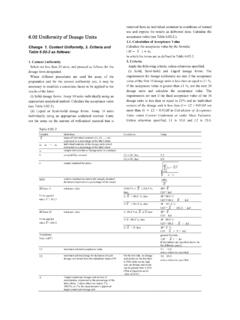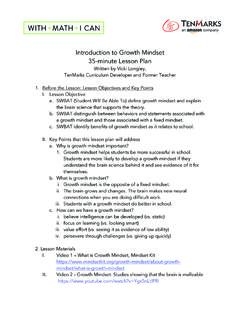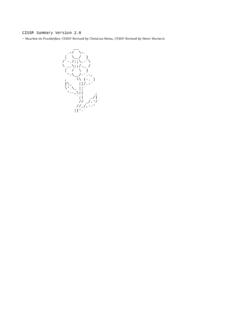Transcription of Inherent Factors Affecting Soil Nitrogen - USDA
1 Page 1 Guides for Educators Nitrogen (N) is the most abundant element in the atmosphere and is usually the most limiting crop nutrient. Nitrogen cycles through soil in various processes and forms. Some processes are necessary to convert N into forms which plants can use. Some processes can lead to N losses such as leaching or volatilization. Nitrogen is added to soil naturally from N fixation by soil bacteria and legumes and through atmospheric deposition in rainfall. Additional N is typically supplied to the crop by fertilizers, manure, or other organic materials.
2 Soil nitrate-N is an excellent indicator of N-cycling in soils, whether carryover Nitrogen was used by the previous crop and whether additional Nitrogen is needed. Inherent Factors Affecting Soil Nitrogen Inherent Factors such as soil drainage, soil texture, and slope steepness impact N-transport and N-transformation processes that limit availability to crops or lead to losses. Inherent Factors such as rainfall and temperature; and site conditions such as moisture, soil aeration (oxygen levels), and salt content (electrical conductivity/EC) affect rate of N mineralization from organic matter decomposition, Nitrogen cycling, and Nitrogen losses through leaching, runoff, or denitrification.
3 Organic matter decomposes releasing N more quickly in warm humid climates and slower in cool dry climates. This N release is also quicker in well aerated soils and much slower on wet saturated soils. Nitrogen can readily leach out of the root zone in nitrate-N form. The potential for leaching is dependent on soil texture (percentage of sand, silt, and clay) and soil water content. Water moves more quickly through large pore spaces in a sandy soil than it does through small pores in a clayey soil and water holding capacity is much lower in sandy soils, making them especially vulnerable.
4 Soils that have poor drainage and are ponded or saturated with water causes denitrification to occur resulting in loss of N as a gas which can result in emission of potent greenhouse gases, yield reduction and increased N fertilizer expense. Nitrogen ManagementManagement Factors , such as N-rate, N source, N placement method, timing of application, irrigation management, residue management, crop type, etc. all can affect how efficiently N is used by crops and amount of N losses.
5 Nitrogen management on sandy soils is important because of high potential for leaching losses. Selecting appropriate N rate is the primary management consideration. However, Nitrogen source, timing N application close to plant uptake, and method of application such as injecting N to avoid losses are also important. Management measures that increase organic matter and avoid compaction are also important to stabilize crop N supply, increase aeration, and to limit N losses due to denitrification occurring in saturated soils.
6 Nitrogen rates should be based on amount needed to optimize yield based on agronomic economic and environmental considerations. When planning N-fertilizer or manure application rates appropriate N-credits should be accounted for including; soil Soil Nitrogen Soil Quality Kit usda -NRCS Page 2 Guides for Educators test residual nitrate-N, soil organic matter mineralization, legume credits, manure or other organic amendments, irrigation water nitrate-N, residue decomposition and natural N sources.
7 Time N fertilization to provide adequate amounts of N when plants are actively growing and using N rapidly. Losses of applied N from fertilizer can be reduced by delaying application until the crop has emerged (side dressing). Split N applications, where some N is applied prior to crop emergence and the balance after emergence can increase crop N-use efficiency. Fertilizer source is important to increase N recovery by crops, avoid N-loss from volatization and be matched to the type of placement method to reduce losses and maximize recovery by crops.
8 Anhydrous ammonia is usually the least expensive N source, but this material must be handled safely, and must be injected/knifed in with ideal soil moisture conditions. Urea and urea containing materials should be injected to reduce loss from ammonia volatilization. Surface applied urea N fertilizers, should not be applied during warm humid conditions, or on wet residues because of high potential for N losses from volatization.
9 Manure or organic amendments can be an effective N-fertilizer. However, care must be taken to apply manure uniformly at a known rate, and account for mineralization rate. Placement of N-fertilizer can be accomplished by several methods. Typical methods include, side dress applications after crop emergence, knifed application placing a band of fertilizer below the soil surface, broadcast applications that uniformly distribute N, and through sprinkler irrigation systems.
10 Each placement method has its advantages, and must be matched to type of fertilizer or manure that will be applied. Irrigation scheduling is important. The goal is to supply enough water to optimize yield while avoiding excess irrigation which can increase costs and leach N below the root zone. Keys to managing N in most efficient manner include these strategies: 1) Apply recommended rate based on realistic yield 2) Time N application just before peak crop demand 3) Select an ammonium containing fertilizer which provides greater N recovery by crops 4) Inject N if possible to avoid ammonia or volatization losses 5) Use N-inhibitors when N is applied outside of growing season 6) Credit all sources of N 7) Irrigate wisely 8) Monitor crop Nitrogen needs by scouting 9) Regular soil testing for nitrate (including deep samples), and soil salt content (EC)

















